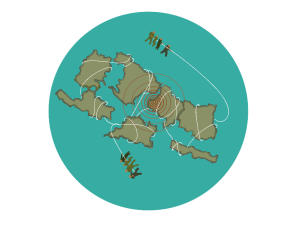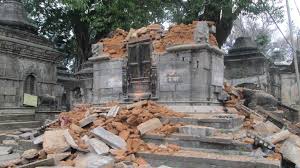 Crumbled houses, starving populations, tarpaulin shelters — even six months after April’s deadly 7.8 magnitude earthquake, ruinous post-disaster conditions are still pervasive in Nepal. In the aftermath of the earthquake, the worst to hit the small South Asian nation in 80 years, over 8,000 people have died, igniting a humanitarian crisis that has captured global attention. Over the past few months, Nepal has seen fundamental changes within its political sphere. In early October, Nepal’s parliament elected the nation’s second-ever president and the first woman to hold the position, Bidhya Devi Bhandari, a staunch advocate for human rights and democracy. At the same time, the country has struggled with the implications of a new constitution — established on September 20, 2015 by then-President Ram Baran Yadav — that has redirected energy from earthquake reconstruction efforts toward the mitigation of political protests and a damaging fuel blockade. Bhandari’s Nepal now faces the reverberations from a geopolitical tug-of-war abroad and ethnic strife at home. Without a reconciliation between entrenched domestic political forces, Nepal’s long-term stability may be in serious jeopardy.
Crumbled houses, starving populations, tarpaulin shelters — even six months after April’s deadly 7.8 magnitude earthquake, ruinous post-disaster conditions are still pervasive in Nepal. In the aftermath of the earthquake, the worst to hit the small South Asian nation in 80 years, over 8,000 people have died, igniting a humanitarian crisis that has captured global attention. Over the past few months, Nepal has seen fundamental changes within its political sphere. In early October, Nepal’s parliament elected the nation’s second-ever president and the first woman to hold the position, Bidhya Devi Bhandari, a staunch advocate for human rights and democracy. At the same time, the country has struggled with the implications of a new constitution — established on September 20, 2015 by then-President Ram Baran Yadav — that has redirected energy from earthquake reconstruction efforts toward the mitigation of political protests and a damaging fuel blockade. Bhandari’s Nepal now faces the reverberations from a geopolitical tug-of-war abroad and ethnic strife at home. Without a reconciliation between entrenched domestic political forces, Nepal’s long-term stability may be in serious jeopardy.
Political tremors are nothing new to Nepal. As the country has lurched from crisis to crisis over the past few decades, altercations between political parties have brought about a faltering economy and faulty governance. In the mid-1990s, a Maoist insurgency developed in order to topple Nepal’s centuries-old monarchy and eradicate years of ethnic and caste inequity within the royal institutions. By 2006, when the rebellion ended, over 20,000 Nepalis had been killed. Following the abolition of the monarchy in 2008, the government instituted a parliamentary democracy, holding an election of a Constituent Assembly in which the Maoist Unified Communist Party of Nepal (UCPN-M) won a majority of seats. However, due to a lack of consensus, the first Constituent Assembly dissolved in 2012. In November 2013, the Nepali Congress and the Communist Party of Nepal (Unified Marxist-Leninist) formed a second Constituent Assembly to alleviate the deadlock within the country. This second Constituent Assembly also failed due to conflicts between political parties over key issues and consequent civil unrest. Through these attempts, deliberations over the recently established constitution have been a perennial source of conflict.
In many ways, the implementation of a new constitution offered hope for a conclusion to the nation’s recent strife. The constitution — Nepal’s seventh in the last 67 years — outlines a new political system, which will divide the country into seven states and establish a federal model in which 60 percent of lawmakers are directly elected, with the remainder selected in proportion to the populations of the seven states. Interestingly enough, the constitution has also outlined progressive provisions calling for the protection of LGBTQ+ rights, making Nepal the first Asian country to explicitly recognize those rights and the tenth in the world to offer the LGBTQ+ population any constitutional protections. Moreover, the document indicates a seismic shift from a traditionally patriarchal society to one that actively includes women in its government, with a requirement that women constitute one-third of the country’s parliament and partake in all government committees. Bhandari was partially responsible for these latter provisions, having actively championed them during the deliberation process.
But these constitutional provisions are by no means the panacea to the nation’s problems. While the document seems to herald progressivism, it has provoked the ire of several marginalized populations inhabiting the southern plains of the Terai region near the India-Nepal border. Minority groups like the Madhesis, Janajatis, and Tharus — who collectively constitute around 50 percent of the country’s population — have criticized the constitution’s implicit focus on a dominant, centralized, and unitary Hindu state. These groups accuse the constitution of privileging Hindu political powers and populations, contrary to its alleged institutionalization of a secular republic. Within the document, the meaning of secularism itself is ambiguous, defined as “religion and culture being practiced since ancient times and religious and cultural freedom,” but it insinuates a continuation of historical Hindu superiority. In addition to secularism, these marginalized populations have called for more government positions and seats in parliament as well as identity-based federalism that adequately represents their populations.
In a way, these constitutional provisions represent a betrayal to many in the Terai area. During the decade-long Maoist war, members of these groups rallied to the Maoist cause and were, as a result, promised autonomous regions. With the UCPN-M as a key political factor in the deliberation process, the implementation of such an exclusionary document feels like a slap in the face.
Yet the constitutional provisions are also reflective of systematic discrimination against minority groups, which runs deep within the sinews of Nepal’s history. Under a new citizenship provision, for instance, the children of women married to foreigners will not receive citizenship at birth but can instead become naturalized citizens. The Madhesis — longstanding victims of societal exclusion due to their cultural and linguistic ties to India — allege that the provision disproportionately targets their people, who often marry Indians across the border. Moreover, many marginalized groups argue that dividing their territory into several provinces is a strategic move to depolarize them and prevent their political consolidation.
Nor is this the first time that these groups have expressed their desire for robust political representation. In fact, their worries largely reflect conversations from the first Constitutional Assembly between 2008 and 2012 , when identity-based models of federalism, albeit unsuccessfully, formed the core of debates about the delineation of provinces. In 2007, an interim constitution included several of these demands, guaranteeing proportional representation and establishing quotas within the government for marginalized populations. Yet framers of the document largely amended many of these clauses for their own ends before finalizing the newest constitution.
If the situation wasn’t already bad enough, the unrest surrounding the new constitution has spilled into India, whose geographic proximity to the protests and ties to the Madhesis have prompted New Delhi to intervene. Hours after the announcement of the constitution, the Indian Foreign Ministry released a statement expressing concern “that the situation in several parts of the country bordering India continues to be violent.” During the weeks of violent protests following the announcement of the constitution, the Madhesis blocked the main crossing point on the 1,751 km open border between the two neighbors, which inhibited the movement of vehicles and, most importantly, fuel.
For years, India has monopolized fuel imports into Nepal, typically supplying around 100,000 tons of fuel each month. Yet in the days following the Madhesi blockade, Nepal stopped receiving all imports from India, even through unobstructed points of entry. After releasing its statement, the Indian government apparently imposed an unofficial blockade on fuel exports into Nepal, which has led to a paucity of relief materials for refugees in post-earthquake conditions. These allegations have led to a shouting match between the two countries: While India vehemently opposes the unrepresentative nature of the constitution, it continues to deny Nepal’s accusations of its involvement in the fuel blockade. The two countries’ deteriorating relationship has perhaps only been worsened by the recent death of an Indian youth by police gunfire in early November during a Madhesi protests.
Chinese involvement may provide the key to silencing Nepal’s indignant neighbor. At the end of October, China announced that it would provide Nepal with 1.3 million liters of gasoline, alleviating the crushing fuel shortages. The agreement between the two nations comes at a critical strategic juncture for China, which has been vying with India for influence over Nepal for years. Yet shipments from China raise logistical concerns, as the border between the two countries runs along the world’s highest mountains and two key passageways were destroyed in the April earthquake, although one has recently reopened. If China can make it through, however, its rush to the rescue will once again allow aid agencies access to populations still in need of supplies months after the earthquakes.
Unfortunately, the situation in Nepal still looks bleak. Even as fuel flows in, displeased marginalized populations aren’t going away, and ethnic conflicts will likely persist until the government responds favorably. The Nepali government scheduled talks with the United Democratic Madhesi Front on November 9, but the meeting was indefinitely postponed. But until the constitution adequately includes the marginalized populations, it’s unlikely that the government can appease them at all — especially while India exerts pressure on their behalf. Furthermore, in the short period that she’s been in office, Bhandari has already faced a good deal of criticism. Many opponents of the new president focus on her role in supporting citizenship provisions that are allegedly antiwomen, namely ones that prevent women from passing along their citizenship status to their children if they’re married to a foreign national.
While Bhandari’s role as president is largely ceremonial and comes with little legislative influence, her leadership might still be the catalyst for change that Nepal needs. As the first female president and a relatively progressive politician, she may be the key to reconciliation between politicians and opponents of the constitution as well as fundamental political changes within the country. But after decades of a contentious political battlefield, and considering Bhandari’s alleged shortcomings, perhaps the new president’s progressive agenda won’t be enough to singlehandedly uproot the system. Without tectonic shifts, Nepal may find it increasingly difficult to ever emerge from the rubble.
Art by Soraya Ferdman
